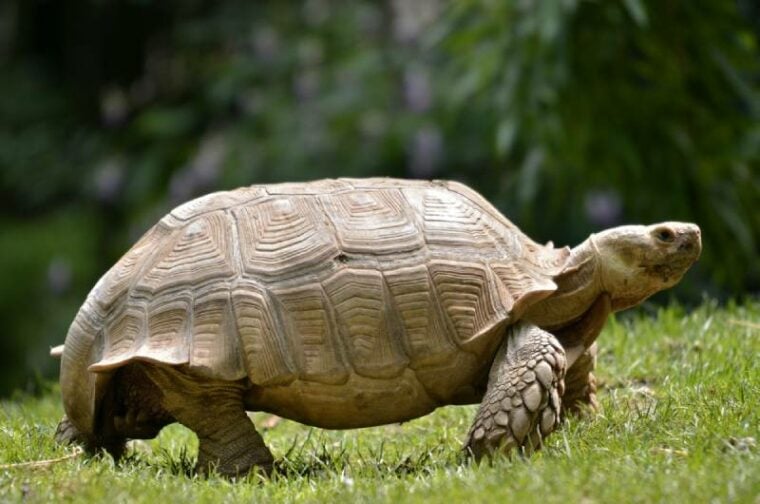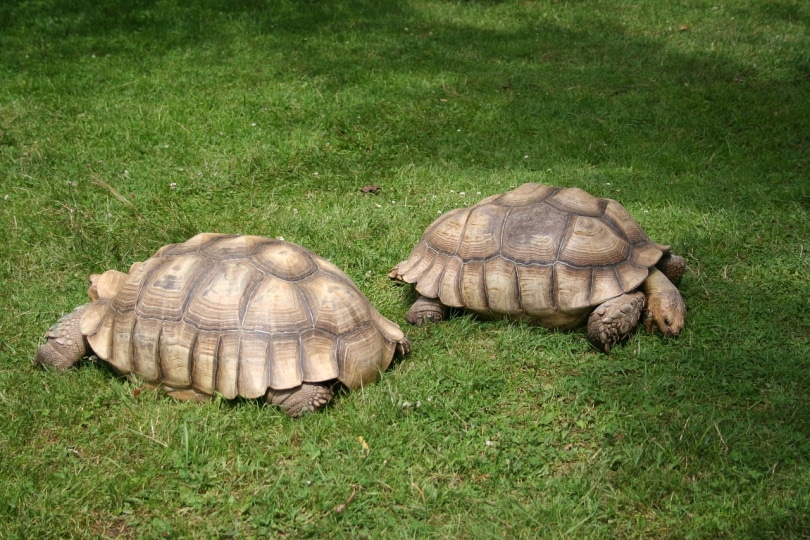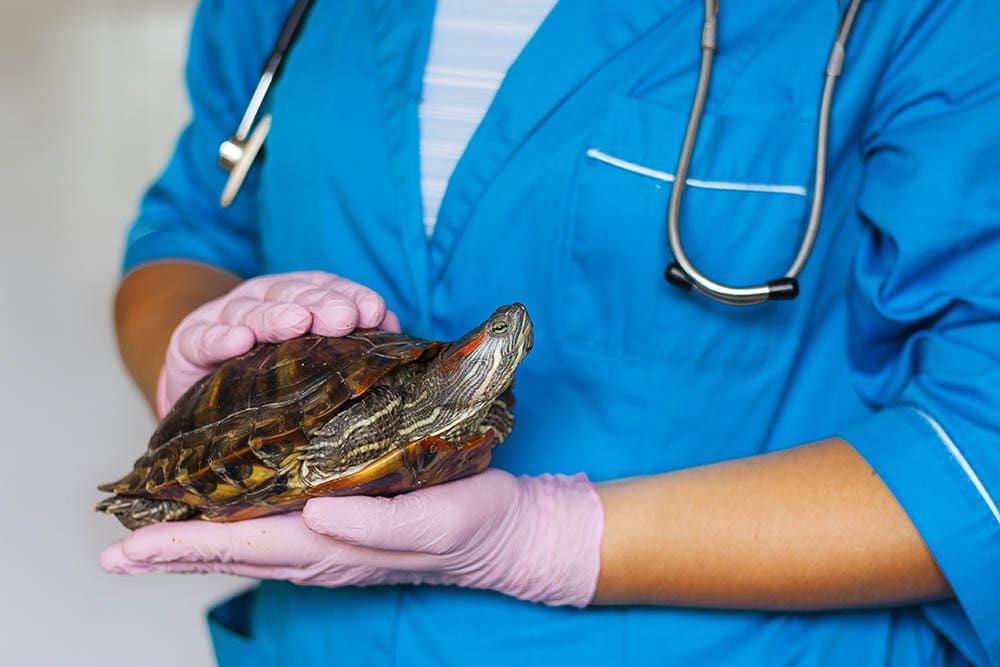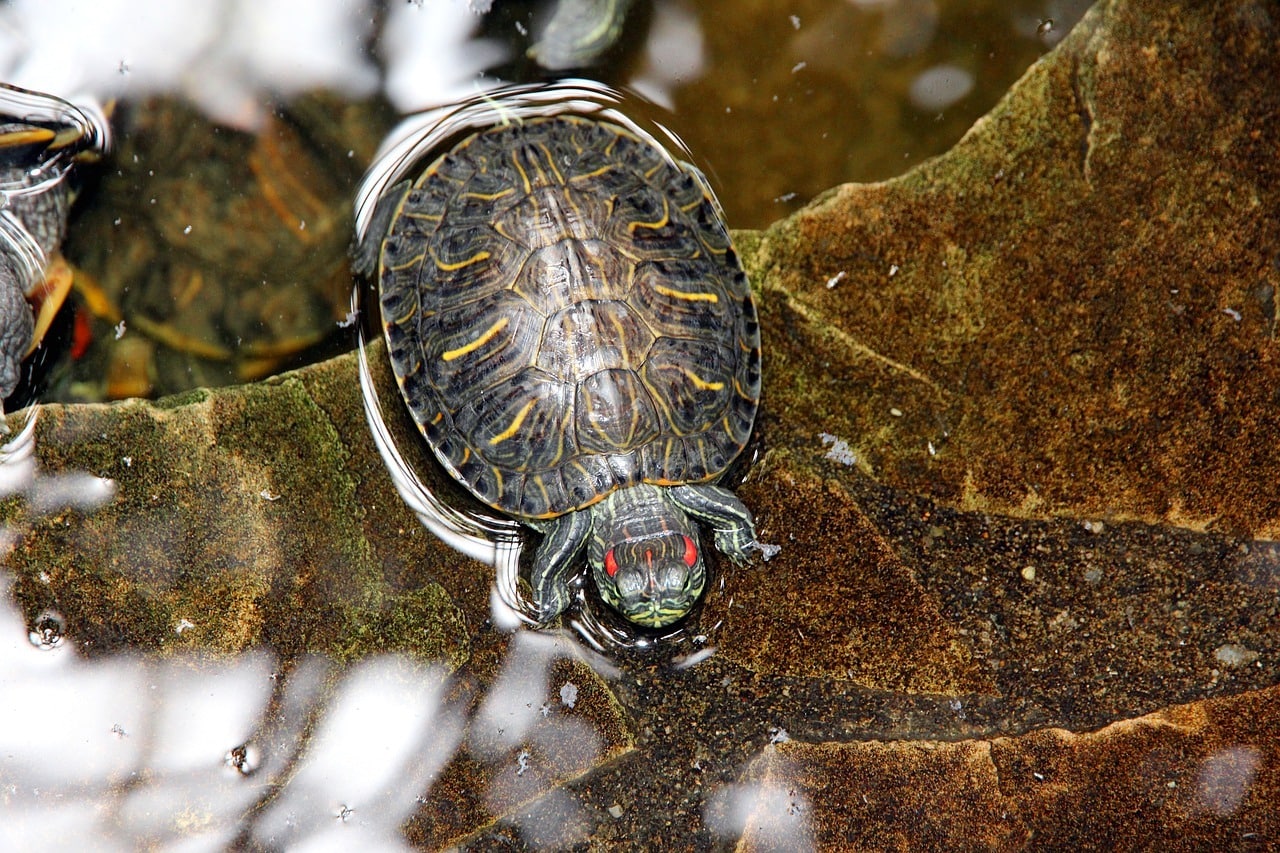
Click to Skip Ahead
| Size: | 18 to 30 inches |
| Weight: | Up to 200 pounds |
| Lifespan: | 70 years or more |
| Suitable for: | Young owners who will grow up with the tortoise and don’t mind long-term care |
| Temperament: | Adaptable, quiet, and curious |
Although native to Africa, Sulcata Tortoises are kept as pets worldwide because of their adaptability to different climates. If you plan to keep an African Spurred Tortoise as a pet, know that they can outlive you. They also have particular care requirements that some owners might find hard to fulfill.
Since they grow up to be much bigger than other tortoises at up to 30 inches, they also need bigger tanks. While most of them weigh about 100 pounds, some males maybe 200 pounds.
If you can look past these things, let’s learn how to care for the largest species of mainland tortoises.
African Spurred (Sulcata) Tortoise Characteristics
How Much Do These Tortoises Cost?

Buying an African Spurred Tortoise isn’t hard since the breed is sold as a pet in the US. However, you should do thorough research to find a reputable breeder. After all, the African Spurred Tortoise will live in your house for decades. You need to ensure the animal comes from a healthy stock to prevent stress and monetary burden later on.
On average, you can find a Sulcata Tortoise for $50 to $1,500, depending on your location and the animal’s age. It’s common to buy these tortoises when they’re young rather than fully-grown adults.
Since many people find it hard to care for a Sulcata Tortoise once they reach a certain age, these tortoises are often rehomed. You might be able to find an older tortoise at a lower price.
When buying from a breeder, choose a tortoise with a smooth shell and clear eyes. Ask the breeder if you can see the Sulcata eat since the breed is known for its voracious eating behavior. Watching an African Spurred Tortoise gobble up a ton of food in front of you can confirm its healthiness.
African Spurred (Sulcata) Tortoise Behavior
Like any other tortoise, a Sulcata Tortoise will also spend time quietly in their tank. They are slow creatures slowed down even more due to their large body size.
If the tank isn’t big enough for the tortoise, you’ll have to dislodge the animal from narrow spaces, as they get stuck easily. The Sulcata Tortoise also flips over often. Since they cannot get the right side up on their own, they’ll need your help.
Apart from this, they’re pleasant creatures that rarely show territorial behavior. They’re also not prone to aggression. However, you should not handle them excessively when they’re young. That’s because it can cause stress, resulting in their death or severe health problems.
Do These Turtles Make Good Pets?
African Spurred Tortoises only make good pets if you can commit to looking after them in the long run. When getting a Sulcata Tortoise, you have to consider their long lifespan. It’s likely that you will have to hand over their care to someone else in your lifetime.
If the age and size aren’t problems for you, Sulcata Tortoises make intelligent and curious pets. They do not bother you much but are a treat to have around.
African Spurred (Sulcata) Tortoise Tank Mates
Being a solitary animal, the Sulcata Tortoise does not need a tank mate. Unlike dogs, they do not get up to aggressive behavior if they’re not given sufficient attention.
Also, your Sulcata Tortoise will take up most of the space in the tank, leaving little to no room for another reptile. You should keep the Sulcata Tortoise separately to prevent space issues.

Care Sheet & Habitat Setup: African Spurred (Sulcata) Tortoise
A Sulcata Tortoise will be in your life and home for a long time. So, you must provide a comfortable environment for your pet.
Light Requirements
The light requirements you provide to the Sulcata Tortoise will depend on where you keep them. If their tank is outside, the sunlight will suffice. But if you keep them inside, invest in a UVA/UVB light. They require unfiltered sunlight to stay healthy. Proper light exposure also results in healthy bone growth.
Remember that Sulcata Tortoises come from Africa and need hot temperatures to thrive. In their native habitat, the temperatures can go up to 120° F. These tortoises dig dens in the ground and recline there to stay cool.
They can withstand up to 100° Fahrenheit. However, you must create a shady spot for them in the tank with a temperature of 75° to 85° for them to cool off. The temperature should not drop under 60° F at night. If that happens, you’ll have to provide a supplementary heat source for the Sulcata in the tank.
Tank Size
It’s possible to keep a Sulcata Tortoise in a tank when they’re young. Once they grow old, keeping them in such a confined space may not be feasible unless you have a huge tank or room to house them.
The best alternative is to keep these tortoises in an enclosure outdoors. For example, you can keep your pet in a greenhouse or a shed with the proper temperature and light required for their swift growth.
If you keep the Sulcata Tortoise in an enclosure, install a fence around it too. The fence must be about 2 feet in height above the ground and 1 foot extended below it. Since the Sulcata Tortoise digs dens, there should be enough fencing underground to keep them from escaping.

Plants
In their natural habitats, Sulcata Tortoises have access to various plants. You should try to replicate that when keeping them as pets.
Grow natural vegetation in their enclosure, with tussock grass and low shrubs. They like to shelter under the tall grass from the sun. Also include logs and rocks. The tortoise likes to use them as visual barriers. You may also see your pet pushing the rocks around.
Since Sulcata Tortoises like to burrow, you must include artificial burrows in their enclosure. For example, you can put some straw or a cut-grass bundle in a corner.
Besides plants, you should also have a small pond in the enclosure. It should have shallow sides so your pet can enter and exit easily. Tortoises spend most of their time on land but like to immerse in water every now and then.
Substrate
When replicating the wildlife conditions for burrowing species, work with soil and sand as substrates. You can combine the two to form a bedding material.
Use a mixture of soil, peat moss, and coconut coir when your Sulcata Tortoise is still young and is being kept in a tan. Sphagnum moss is also a good addition to this mixture.
Things to Know When Owning an African Spurred (Sulcata) Tortoise
Food & Diet Requirements
Being herbivores, Sulcata Tortoises munch on hay and grass. They can also eat flowers like clover and dandelions. You may feed them some vegetables, but make sure they’re not oxalate-rich. Some veggies to avoid are kale, okra, and spinach.
It’s best to consult a vet to learn about the best diet for your tortoise. If they’re kept in an enclosure outside, best believe that the tortoise will pretty much eat any leafy thing that grows there. So, keep an eye on what grows in the greenhouse or shed.
Although you can find some commercial pelleted diets for tortoises, these are often rich in starch. They also lack the nutritional balance your pet needs. Vets and reptile experts have varying opinions on whether tortoises should be given supplements. However, you can supplement your pet’s diet with light calcium powder dusting twice weekly. Supplementation helps the tortoise during gestation and growth spurts.
If you keep your pet outside with exposure to full, unfiltered sunlight, do not give them any vitamin or calcium supplements. Non-breeding Sulcata Tortoises also do not require supplementation.
You should also keep a shallow bowl of water in the enclosure for your pet to soak in. A slight issue in this regard is that tortoises tend to defecate in the water bowls. So, you may have to clean the bowl a few times during the week.
An alternative to this is to bring your tortoise out of their tank a couple of times a week and soak them in a wash basin for 30 minutes. But once the Sulcata grows large, this won’t be possible. Instead, you’ll need to provide them with a pond or a large tub of water to soak in.
Size & Growth Chart
Sulcata Tortoises are about 1.5 to 2 inches in size when they are three weeks of age. By 90 days, they have grown to 2.5 inches and weigh 0.12 pounds. At the age of one, a Sulcata Tortoise is about 6 to 8 inches in size. They grow a few inches to reach a length of 10 inches by the age of 6.
From ages 10 to 12, the tortoise grows rapidly, reaching a size of 20 inches. They weigh nearly 17 to 20 pounds at this point. At 15 years of age, they are now mature and can reproduce.

Lifespan and Health Conditions
Sulcata Tortoises live for 70 to 80 years when healthy. However, they are prone to several health conditions in captivity.
Serious Conditions
Respiratory infections are common in tortoises living in humid environments. You can prevent this by soaking your pet yourself or giving them a shallow water bowl or pond to cool themselves off.
Another serious condition that affects Sulcata Tortoises is shell rot. It results from a fungal infection, causing the animal’s shell to become dry and flaky. When that happens, your pet is exposed to external factors, like the harsh sun.
Minor Conditions
Sulcata Tortoises are most active from July to October in the rainy season. If the temperatures are too extreme, the tortoise will form an underground den for themselves. However, if they fall on their backs, they could suffer from hypothermia and die.
Male vs. Female
Male and female Sulcata Tortoises differ from each other in size and weight. Males can be up to 30 inches in size and weigh 100 to 200 pounds, whereas females are 20 inches long and weigh up to 90 pounds.
3 Little-Known Facts About African Spurred (Sulcata) Tortoise
1. Female Sulcatas Gestate for 60 Days
Sulcata Tortoises have a gestation period of 60 days. Every clutch has 15 to 30 eggs that incubate underground for eight months.
2. Sulcatas Can Drink a Lot
Although Sulcata Tortoises can live without food or water for weeks, they will drink nearly 15% of their body weight in water when they find a hydration source.
3. Sulcatas Grow Slowly
When they hatch, Sulcata Tortoises are 2 inches in size. They become mature at the age of 15.
Final Thoughts
While it’s true that the African Spurred Tortoise makes a great pet, you should be prepared to look after the reptile for decades. When it comes to health and diet, Sulcata Tortoises don’t differ much from other species.
However, it’s the space and burrowing requirements that might make it hard for many people to keep them as pets. If you have ample space in your yard for a shed or greenhouse for a Sulcata Tortoise, you can keep this beautiful and docile pet in your home. With proper care, they can live for as long as you do.
Featured Image Credit: Christian Musat, Shutterstock







